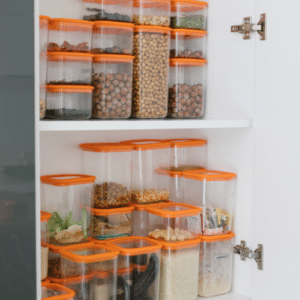
03 Feb No More Food Invaders
Pantry Pest Problems Solved
Pantry pests are some of the most frustrating household invaders, often appearing when least expected. These tiny insects infest dry goods, contaminating food and making storage areas unsanitary. Their ability to thrive in warm, humid environments makes South Florida homes and businesses particularly vulnerable. Without proper prevention and pest control, these insects can multiply rapidly, leading to widespread infestations.
As a family-owned organic pest control company, Pest Busterzz understands the importance of keeping homes and businesses pest-free. Pantry pests can invade kitchens, restaurants, grocery stores, and food storage facilities, putting food safety at risk. Knowing how these pests enter properties, what signs to look for, and how to eliminate them ensures a healthier and safer environment. This guide explores the most common pantry pests, how they spread, and the best ways to keep them under control.
Protect Your Kitchen Staples
Indian meal moths are one of the most frequent pantry pests found in homes and businesses. These small moths have reddish-brown wings with a coppery sheen, making them easy to identify. They lay eggs in dry goods such as flour, grains, nuts, and even pet food. Once hatched, the larvae spin silk webs inside food packaging, contaminating entire supplies.
Infestations often start when a single contaminated product is brought home from a grocery store. Larvae feed and grow inside packaging, eventually emerging as adult moths. If left unchecked, they spread quickly, moving from one food container to another. Homeowners and business owners should inspect stored goods regularly and discard any items with visible webbing or larvae. Proper storage in airtight containers reduces the risk of infestation.
Flour beetles, including red and confused flour beetles, are notorious for infesting pantry staples. These tiny, reddish-brown beetles thrive in flour, cereal, and baking ingredients. They contaminate food by secreting chemicals that give it an unpleasant odor and taste, making products unfit for consumption. Unlike other pantry pests, flour beetles do not directly feed on whole grains but instead thrive in processed foods.
These beetles often enter homes through infested store-bought goods. Once inside, they reproduce rapidly, making early detection essential. Flour beetles can survive for months in dry goods, often going unnoticed until large numbers are present. Regularly checking food storage areas and discarding expired products can prevent infestations. Sealing cracks and crevices in pantries helps reduce the likelihood of these pests spreading.
Weevils are small, long-snouted beetles that target whole grains such as rice, wheat, and corn. Unlike other pantry pests, they lay eggs inside individual grains, making infestations difficult to detect early. As the larvae develop, they consume the grain from within, leaving behind hollow husks. Weevils are commonly found in bulk food bins, flour, pasta, and dry beans.
Because weevils can burrow deep into food, infestations often go unnoticed until damage becomes widespread. Affected grains may appear clumped together or have small exit holes where adult weevils have emerged. Freezing grains for a few days before storing them can help kill any hidden larvae. Keeping pantries clean and rotating food supplies ensures that infestations do not become severe.
Stop Food Contamination Now
Pantry pests often enter homes and businesses through packaged food. Infested products from grocery stores, bulk food bins, or even pet food bags can introduce these insects into storage areas. Most pantry pests are small enough to remain hidden inside sealed packaging, making it easy for them to spread. Once inside, they move from one product to another, laying eggs and contaminating food supplies.
Inspecting all dry goods before storing them reduces the risk of infestation. Look for signs of insects, webbing, or unusual odors. Avoid purchasing bulk food items that have been exposed to the open air, as these are more likely to contain pests. Transferring dry goods into airtight containers also prevents infestations from spreading.
Once inside, pantry pests hide in small cracks and crevices, making them difficult to eliminate. They can squeeze into spaces between cabinets, behind appliances, and even inside food packaging. Warm and humid conditions allow them to thrive, leading to rapid reproduction.
Regularly cleaning pantry shelves, vacuuming storage areas, and sealing gaps around shelves and walls help prevent infestations. Even small amounts of spilled flour, sugar, or grains can attract pests. Keeping food storage areas clean and well-organized minimizes the risk of hidden infestations.
Watch for Pantry Pest Clues
One of the most obvious signs of a pantry pest infestation is the presence of live insects inside food packages. Small beetles, moths, or larvae in grains, flour, or cereal indicate a problem. Pantry pests often leave behind webbing, shed skins, or fine dust as they feed.
Checking stored goods regularly and removing any infested products prevents pests from spreading. If an infestation is discovered, discarding affected items and deep cleaning storage areas helps remove lingering pests.
Pantry moths spin silk webbing as they develop, leaving visible signs along pantry shelves and inside food containers. Tiny holes in food packaging, clumped-together grains, or a musty smell may also indicate an infestation.
Regularly wiping down storage areas and inspecting stored goods can help catch infestations before they spread. Using natural deterrents such as bay leaves or cinnamon can also discourage pests from settling in pantries.
Lock Out Food Invaders
The first step in eliminating pantry pests is to identify and remove infested products. All dry goods should be carefully inspected, and any contaminated items should be discarded immediately. Sealing infested products in plastic bags before disposal prevents pests from spreading.
After removing contaminated food, deep cleaning storage areas helps eliminate any remaining eggs or larvae. Using a vacuum to clean pantry shelves, corners, and crevices removes hidden pests. A solution of vinegar and water can be used to wipe down surfaces and deter future infestations.
Storing food in airtight containers is one of the best ways to prevent pantry pest infestations. Glass, plastic, or metal containers with tight-fitting lids keep pests out and help preserve food quality. Labeling and dating stored goods ensure that older items are used first, reducing the chance of pest problems.
Keeping pantry shelves organized and free of clutter makes it easier to spot infestations early. Regularly rotating stored goods ensures that food is not left sitting for long periods, minimizing the risk of attracting pests.
Conclusion
While DIY methods can help reduce pantry pest populations, professional pest control ensures complete elimination. Pantry pests reproduce quickly, making it difficult to control infestations without expert assistance. Store-bought pesticides may not be safe for food storage areas and often fail to address the root cause of infestations.
Pest Busterzz offers safe and eco-friendly pest control solutions tailored to South Florida’s climate. Our organic treatments target pantry pests while keeping food storage areas safe for families and businesses. We provide long-term solutions that prevent future infestations and protect stored goods.
Pantry pests can quickly turn food storage areas into a breeding ground for contamination. Understanding how these pests invade homes and businesses, recognizing the signs of infestation, and taking preventative measures can help keep food supplies safe.
For long-term protection, Pest Busterzz provides expert pest control solutions that eliminate pantry pests at the source. Our family-owned company specializes in organic and non-toxic treatments, ensuring homes and businesses stay pest-free. Contact us today for a customized pest control plan and keep your pantry pest-free!






No Comments